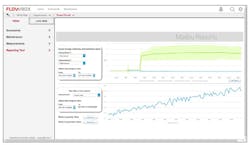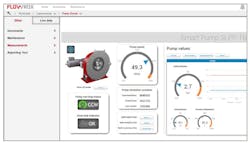A digital transformation began many years ago, and the growth of digitalization during the coming years will be staggering. It is estimated that by 2020 more than 50 billion devices will be connected to the Internet of Things (IoT). Pump manufacturers and processing plants of all types are beginning to tap into vast amounts of data to better monitor and control process equipment and processing facilities.
For assets such as pumps, condition monitoring can unlock many early warning signs that an asset is in trouble. These early indicators are pre-warnings of upcoming downtime. They give processing plants time to perform preventive proactive maintenance to avoid undesirable downtime. If early warnings are heeded, the process plant can reap tremendous savings in repair costs and prevent lost production time. It is estimated that a sizeable process plant that uses connected assets and intelligent monitoring can improve production to the extent that it could gain as much as one additional month of production per year.
Pump manufacturers can make their products intelligent like the smart peristaltic pump illustrated in Figure 1.
This pump monitors pump vibration, motor vibration, pump temperature, motor temperature, inlet pressure, outlet pressure, gear box lubrication oil temperature, power, current, speed and speed adjustment. When the pump is new, advanced diagnostics help determine normal operating parameters. As the pump ages, these diagnostics begin to create a picture of wear and fatigue for the user. As the pump deteriorates beyond a certain deviation of normal, warnings can be triggered to take proactive preventive maintenance and eliminate or minimize undesirable downtime and, even worse, the pump running to destruction.
A pump is just one of the many assets in a process facility. Many assets in different kinds of processing plants can capture valuable digital information. Some assets already have digital output, but others that do not already can easily be connected by adding “lick and stick” digital outputs. These digital monitoring devices are inexpensive and can be added to almost any asset.
Intelligence goes a long way
To understand how intelligent monitoring can go well beyond a pump or individual asset, a user can review a typical thickener underflow application where a peristaltic pump is often found. In many cases, a thickener provides a thickened feed to a pressure filter.
The peristaltic pump is ideal for thickener underflow when compared to a centrifugal pump for many reasons. First, a peristaltic pump can handle high solids content successfully up to 80 percent solids and beyond. Typical centrifugal pumps can efficiently handle 35 percent solids, but if pushed to 50 or 55 percent solids, the wear rate of thepump’s internal components is severely impacted resulting in much higher maintenance costs. When stopped, the peristaltic pump is its own shut-off device. The hose is compressed, and no flow can pass through the pump, unlike centrifugal pumps that allow flow even when stopped.
With a thickener, the user thickens a slurry for further processing or disposal. A peristaltic pump requires no gland seal water, and no gland seal water is added back into the thickened process. Centrifugal pumps require clean gland seal water that is re-induced back into the thickened slurry.
Finally, a peristaltic pump is a positive displacement device and provides an exact flow per revolution, so the pump is accurate and controllable simply by increasing or decreasing the revolutions per minute. This is unlike a centrifugal pump, which has a specific pump curve and may become uncontrollable if operated below its curve.
Smart solutions can improve the thickener underflow control by monitoring the entire thickening process. By better controlling the thickener to produce consistent solids percentage and density, the owner of that thickener can achieve strong savings depending on what the thickener is feeding. If, for instance, the thickener only thickens for disposal, less water may go to the landfill, and less money may be paid for shipping water and to the landfill on tonnage.
If the thickener is feeding to a filtration plant, significant savings can be reached by better controlling the thickener and pumping process as two pieces of machinery working in unison to produce the desired output. If the thickener produces a less-than-optimal slurry rate, more retention time in filtration may be required.
If thermal drying is required after filtration, the costs of poorly thickened slurry can be quite extreme. These costs can often be as significant as several hundreds of thousands of dollars per year.
Platform solutions
All the solutions described so far in this article are examples of better monitoring. Process control is enhanced by smart solutions. Additional savings can be captured from the right solution package. One particular customized monitoring of smart pumps and valves also includes a comprehensive maintenance package. It creates a 3D virtual environment of the asset or even a complete process facility and attaches all documentation such as user manuals, drawings, spare parts, repair videos and animations to each monitored asset.
From the user interface, the operator can view from a smartphone, tablet or PC to instantaneously pull up all information required to save a troubled asset. The user can see service history, previous solutions for troubleshooting and all safety documentation. Maintenance personnel in a typical process facility may spend four to eight hours researching documentation before beginning work on a troubled asset. With a user interface like the one described, personnel will have all the data required to begin immediately, all with one username and password. They will not have to visit numerous locations and systems in the plant, often each with a different username and password. These new smart systems bring speed to early warnings and prevent totally disabled assets.
Conclusion
With the retirement of the baby-boom generation, much experience will be lost. Newer generations have grown up with smartphones and tablets and are part of the point-and-click generation. They want and will drive solutions that are more visual and operate in the point-and-click environment. Smart systems, smart valves and smart pumps will drive greater productivity. Just about any device or system can be made smart, and process plants of all types can begin to reap the rewards of greater connectivity, intelligence and instantaneous feedback on asset health.
Todd Loudin is president of North American operations for Flowrox.






